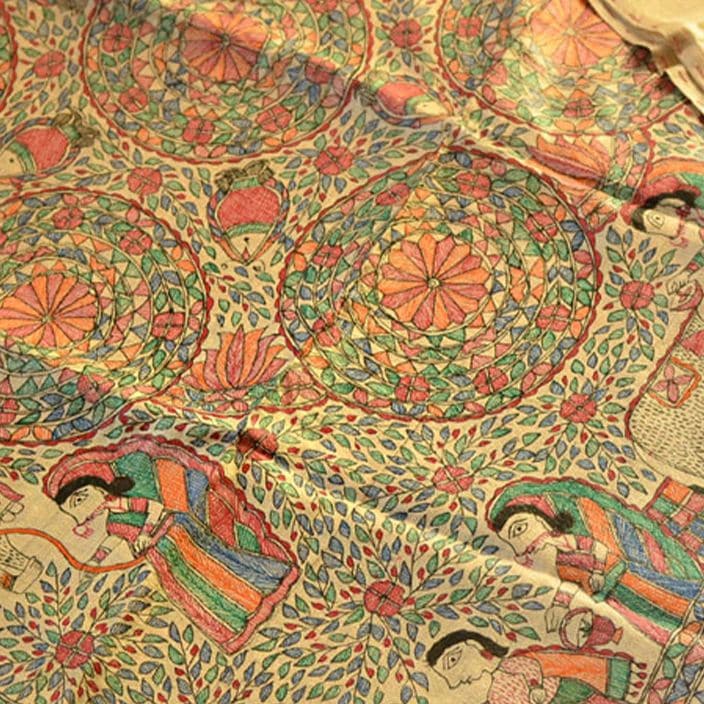For best prices and early deliveries, WhatsApp us at. 918488070070
Bihar
Known as the land of Buddha, Bihar is a culturally rich state predominantly influenced by religions, particularly Hinduism and its mythology. Diverse in its true essence, the state is vibrant, fascinating, and unreserved. Bihar’s culture has been impacted by famous epics like the Ramayana and Mahabharata and its neighbouring states, which consist of Nepal, Uttar Pradesh, West Bengal, and Jharkhand. Traditional clothing of the state is not divided as per the variety of cultures but remains synonymous amongst all religions that have made Bihar their home.
Traditional Bihari Clothing
Women
The women residing in Bihar mainly prefer to adorn the timeless six yards of absolute grandeur - a saree. Found in a wide variety of shades, fabrics, and designs, it is among the most famous traditional dress of Bihar’s clothing and the majority of India. A saree can be draped in many ways — modern or traditional — but the Bihari style is called 'Seedha Anchal.' The saree's pallu goes over the left shoulder, covering the body's upper portion from the front. Some women prefer to cover their heads with their pallu, while some do not.
Ghagra choli, more commonly known as 'lehengas,' are considered part of a fancy attire reserved for special occasions like family events, festivals, and weddings. Like sarees, they are also available in various colours, designs, and materials.
The look while wearing either a saree or ghagra choli is completed with 'sindoor'- a red powder added along the part of the woman's hairline. This is symbolic of her marital status and visually indicates the same. Jewellery is also worn with the outfit to highlight it more, standing out against the crowd.
Men
Bihari dresses for men are generally seen wearing the dhoti mirjai, a kurta, and dhoti/lungi. Made from cotton, this attire is very comfortable and worn by everyone — from young boys to teenagers to middle-aged and older men. A dhoti is a type of loose pants that wrap snugly around the legs with a knot at the waist for a more conventional look. Lungi is a sarong tied below the navel area and is popularly known as men's traditional skirts. This garment provides a very casual look, while dhotis can be worn for fancier purposes as well. Fancier dhoti mirjais are adorned with lavish borders and heavy embroidery, found in both vibrant and muted colour combinations.
Kurta and pyjama are also worn by men on a daily basis. A kurta is a long, loose shirt that ends at the knee. It's made with materials like silk and cotton, and the designs vary as per the occasion it is being worn for. For everyday use, kurtas have very minimal embroidery and motifs spread throughout their length. Fancy kurtas have chikan motifs and other kinds of heavy embroidery.
A sherwani is the main festive attire of men in Bihar and all over India. It is a coat-like kurta worn on top of a dhoti or pyjama. Sherwanis are available in an astounding variety of colours, designs, prints, and styles. At times, they have intricate and heavy work done on them too.
Staple Jewellery & Accessories
Bihar's profuse artistic culture is further represented by its traditional jewellery, which is truly a work of art crafted by hand.
A Hansuli is a necklace made from gold that appears to represent a thick band wrapped around the neck. The Dhokra tribes are infamous for designing traditional hansulis. The chandrahar is a long necklace made with pearls of gold and has beautiful floral designs with dual lockets on both sides. A panchlari is a five-layered necklace, traditionally made with pearls and colourful precious stones. The Sita haar is a long gold necklace that comes to the wearer's waist, usually accompanied by smaller neckpieces. A satlari has seven layers and is dazzled with pearls and exquisite gems. Dholna is a necklace shaped as a dhol, a musical instrument, worn for weddings and festive occasions. Similar to the maang tikka worn all over India, Bihar's tikli is a gem-studded headpiece added to the centre parting of a woman's hair. The nath is a bold statement piece worn by women for special occasions, particularly weddings.
It's worn on the nose and has a long chain that can be attached to their hair for more support and stability. Bangles are a big part of a Bihari traditional dresses of women - they are vibrant and delicate, beautifully adorning their wrists. The kamarband is a waist belt or chain with bells and other dangling ornamental elements. A mauri is a headpiece conventionally made from date or mango leaves, but nowadays, it's also made from mirrors and paper. It is typically worn by brides during their wedding ceremony. Bichua is a toe-ring worn by married women on their middle toe, signifying their marital status. This accessory is not limited to Bihar and Bihar dresses but is also worn by brides all over India.
Fashion Evolution
Relatively well known for its traditional Madhubani print and the fine Bhagalpuri silk, popular as Tussar silk, Bihar is a unique state. It appreciates art in its most authentic form, which is inherent in how it continues to follow ancient tradition. A wholesome Bihari experience is one where the fascinating architecture, delicious food, and unique art all come into play. History and traditions bind with contemporary trends, and modern-day advancements are one of a kind.
Fashion in Bihar, Uttar Pradesh, and Assam has evolved over the years, reflecting the changing trends and tastes of the people in these regions. From traditional attire to fusion wear and modern fashion, the fashion evolution in these states is a testament to their rich cultural heritage and contemporary sensibilities.

